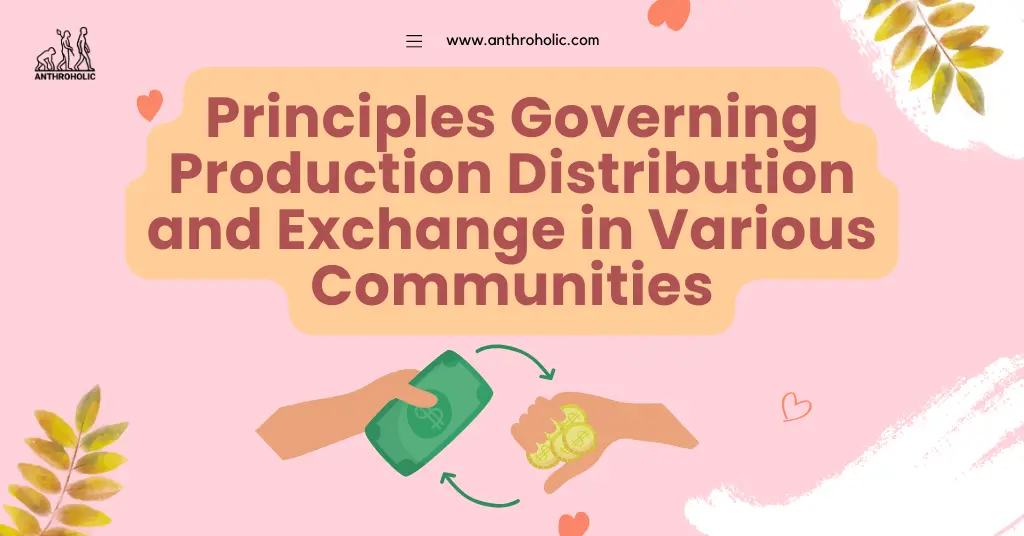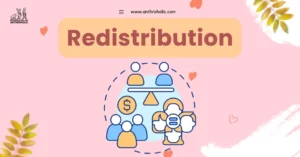AI Answer Evaluation Platform Live Now. Try Free Answer Evaluation Now
Principles Governing Production Distribution and Exchange in Various Communities
Anthropologists have long studied the diverse methods employed by different communities to manage resources. They focus on the principles that govern the production, distribution, and exchange of resources, aiming to understand the cultural norms, economic systems, and societal structures that underpin these processes. Among these principles are three key modes of economic organization: reciprocity, redistribution, and market exchange.

These modes manifest differently across communities with various means of subsistence, such as hunting and gathering, fishing, swiddening, pastoralism, horticulture, and agriculture. This article examines how these principles operate within each of these distinct subsistence economies.
Reciprocity
Reciprocity is the mutual exchange of goods or services. This principle implies a relationship of give-and-take, often with the expectation of balanced return over time. It usually occurs in close-knit societies where trust is high and relationships are long-term [1].
Redistribution
Redistribution involves the collection of goods or wealth by a central authority and their subsequent distribution among members of the community. This central authority can be a tribal chief, a council, or a governmental body. The aim is often to ensure a level of equity and balance in the distribution of resources [2].
Market Exchange
Market exchange, the most recognized economic system globally, is governed by supply and demand. Prices are typically determined by these two factors, and transactions are conducted with a medium of exchange, usually currency. This system is prevalent in societies with complex economic structures [3].
Hunting and Gathering Societies
Hunting and gathering societies predominantly rely on reciprocity. There is shared responsibility and distribution of gathered food and hunted game, with strong social norms discouraging hoarding [4].
Fishing Communities
In fishing societies, the distribution and exchange of resources depend on the community’s size and organization. Small fishing communities usually operate on reciprocity and redistribution, where the day’s catch is shared among community members. In contrast, larger fishing societies might use market exchange if the catch is large and can be sold for profit [5].
Swiddening Communities
Swiddening, or slash-and-burn agriculture, involves cutting down vegetation in a patch of land, burning it, and then using the land for farming. Communities practicing swiddening also often rely on a mix of reciprocity and redistribution. The farmed produce is often shared within the community, and any surplus may be redistributed [6].
Pastoralism
Pastoral societies primarily herd animals and move them to fresh pastures as needed. They also usually follow principles of reciprocity and redistribution, especially during instances of drought or disaster when herds might be decimated. However, with increasing contact with market economies, some pastoralists have started participating in market exchange, selling animal products like milk and meat [7].
Horticulture and Agriculture
Horticulture and agricultural communities demonstrate a transition towards market exchange systems, although reciprocity and redistribution still play important roles. In horticulture, a mixture of subsistence farming and exchange or barter is common. As societies move towards intensive agriculture, the use of market systems becomes more prevalent, with surplus produce sold in markets [8].
The table below summarizes the principles used by different communities:
| Community Type | Reciprocity | Redistribution | Market Exchange |
|---|---|---|---|
| Hunting & Gathering | High | Medium | Low |
| Fishing | High | Medium-High | Variable |
| Swiddening | High | High | Low |
| Pastoralism | High | High | Medium |
| Horticulture | Medium | Medium | Medium |
| Agriculture | Low | Low | High |
Conclusion
Understanding the principles of reciprocity, redistribution, and market exchange, and their application in different types of communities, allows for a deeper comprehension of societal structures and economic behaviors. Each principle has a unique and vital role in structuring social relations, supporting survival strategies, and fostering community bonds.
In societies where survival hinges on cooperation, such as hunting and gathering or fishing communities, reciprocity ensures an equitable distribution of resources, reinforcing social ties and mutual dependence. Similarly, redistribution plays a crucial role in such societies, providing a safety net that mitigates the risk of resource scarcity.
As societies grow and their economic activities become more complex, the shift towards market exchange systems occurs. The influence of reciprocity and redistribution decreases as impersonal market transactions become the norm. This is particularly evident in advanced agricultural societies, where surplus production leads to trade, and the concept of private property becomes more prevalent.
While market exchange systems provide benefits such as increased efficiency and specialization, they can also lead to economic disparity and social inequality. Recognizing this, some communities strive to maintain a balance between market exchanges and the principles of reciprocity and redistribution.
In sum, the principles of reciprocity, redistribution, and market exchange play integral roles in shaping the economies of different societies. They offer valuable insights into the diversity and complexity of human societies and provide a foundational understanding of the economic anthropology.
References
[1] Mauss, M. (1954). The Gift: Forms and Functions of Exchange in Archaic Societies. London: Cohen & West.
[2] Polanyi, K. (1957). The economy as an instituted process. In Trade and market in the early empires (pp. 243-270). Glencoe, IL: Free Press.
[3] Smith, A. (1776). An Inquiry into the Nature and Causes of the Wealth of Nations. Edinburgh: Strahan & Cadell.
[4] Lee, R.B. (1968). What Hunters Do for a Living, or, How to Make Out on Scarce Resources. Man the Hunter, 30-48.
[5] Acheson, J.M. (1981). Anthropology of Fishing. Annual Review of Anthropology, 10(1), 275-316.
[6] Conklin, H.C. (1957). Hanunoo Agriculture. Rome: Food and Agriculture Organization.
[7] Dyson-Hudson, R., & Dyson-Hudson, N. (1980). Nomadic Pastoralism. Annual Review of Anthropology, 9(1), 15-61.
[8] Netting, R.M. (1993). Smallholders, Householders: Farm Families and the Ecology of Intensive, Sustainable Agriculture. Stanford, CA: Stanford University Press.
[9] Sahlins, M. (1972). Stone Age Economics. London: Tavistock Publications.
[10] Malinowski, B. (1922). Argonauts of the Western Pacific. London: Routledge & Kegan Paul.
[11] Boserup, E. (1965). The Conditions of Agricultural Growth: The Economics of Agrarian Change under Population Pressure. Chicago: Aldine.
[12] Graeber, D. (2001). Toward an Anthropological Theory of Value: The False Coin of Our Own Dreams. New York: Palgrave.
[13] Mintz, S.W. (1985). Sweetness and Power: The Place of Sugar in Modern History. New York: Viking.




